what literary devices are used in this reading passage
Need to analyze The Ruby Letter or To Kill a Mockingbird for English class, but fumbling for the right hand vocabulary and concepts for literary devices? You've come to the right send. To successfully interpret and psychoanalyse literary texts, you'll eldest need to have a solid foundation in literary terms and their definitions. In this article, we'll help you get familiar nigh commonly used writing devices in prose and poetry. We'll give you a clear definition of each of the terms we discuss along with examples of literary elements and the context in which they well-nig often appear (comedic writing, drama, or other). Before we get to the leaning of literary devices, however, we have a quick refresher on what literary devices are and how understanding them will help you analyze works of literature. Literary devices are techniques that writers use to make over a special and peaked effect in their writing, to convey entropy, or to avail readers see their writing connected a deeper level. Often, literary devices are used graphic for emphasis operating theater clarity. Authors will also use formal devices to get readers to connect more strongly with either a story Eastern Samoa a whole or specific characters or themes. Thus why is it important to know different literary devices and footing? Aside from helping you draw good grades on your literary analytic thinking homework, there are several benefits to knowing the techniques authors commonly use. Being able to identify when varied literary techniques are being used helps you understand the motivation behind the author's choices. E.g., being able to identify symbols in a narrative tail help you figure out wherefore the source might have chosen to insert these focal points and what these might suggest in regard to her attitude toward certain characters, patch points, and events. In addition, existence able to identify literary devices can make a written work's overall meaning operating theater purpose clearer to you. For instance, rent's say you're preparation to read (or Re-read) The Lion, the Hex, and the Wardrobe by C.S. Lewis. By knowing that this particular book is a religious allegory with references to The Nazarene (represented by the character Aslan) and Judas (delineated aside Edmund), it will be clearer to you why Lewis uses certain language to describe certain characters and why certain events happen the means they do. In conclusion, literary techniques are important to know because they build texts more interesting and more fun to show. If you were to read a novel without well-educated any literary devices, chances are you wouldn't be able-bodied to detect many of the layers of meaning interwoven into the story via different techniques. Now that we've gone over wherefore you should spend some time learning formal devices, rent out's take a look at or s of the most important literary elements to know. Down the stairs is a list of piece of writing devices, most of which you'll often come across in both prose and verse. We explain what each literary terminal figure is and give you an example of how it's in use. This literary elements list is arranged in alphabetical order. An emblem is a floor that is used to stand for a more general message about real-aliveness (historical) issues and/or events. Information technology is typically an entire book, novel, recreate, etc. Example: Orwell's dystopian Koran Animal Raise is an allegory for the events preceding the Country Revolution and the Communist era in early 20th century Russian Federation. In the story, animals connected a farm practice animalism, which is essentially communism. Many characters correspond to genuine historical figures: Old Major represents both the founder of communism Karl Marx and the Russian communist leader Vladimir Lenin; the farmer, Mr. Jones, is the Russian Czar; the boar Bonaparte stands for Stalin; and the pig Snowball represents Leon Trotsky. Alliteration is a series of dustup operating room phrases that all (or nearly every) start with the same sound. These sounds are typically consonants to give more stress to it syllable. You'll a great deal come across alliteration in verse, titles of books and poems (Jane Austen is a winnow of this device, for example—just feeling at Pride and Bias and Sensory faculty and Sensibility), and natural language twisters. Example: "Peter Piper picked a peck of pickled peppers." In this tongue tornado, the "p" substantial is repeated at the beginning of every major actor's line. Allusion is when an author makes an indirect reference to a figure, place, event, or idea originating from outside the text. Many allusions make reference to previous works of literature or art. Example: "Check acting so smart—it's not like you're Einstein or something." This is an allusion to the famous real-life theoretical physicist Albert Einstein. An anachronism occurs when there is an (intentional) error in the chronology or timeline of a text. This could be a character who appears in a various time catamenia than when he actually lived, OR a technology that appears before information technology was invented. Anachronisms are often utilized for comedic effect. Example: A Renaissance king who says, "That's dumbbell, dude!" would be an anachronism, since this type of language is real modern and non actually from the Renaissance period. Anaphora is when a Book or phrase is repeated at the beginning of multiple sentences throughout a piece of writing. It's used to emphasize the repeated phrase and call down strong feelings in the audience. Example: A famous example of epanaphora is Winston Churchill's "We Shall Fight on the Beaches" speech. Throughout this speech, he repeats the phrase "we shall fight" while itemisation numerous places where the British U. S. Army will continue battling during WWII. He did this to rally some troops and the British people and to give them confidence that they would still win the war. An anthropomorphism occurs when something nonhuman, such as an animal, place, or inanimate object, behaves in a imperfect-alike right smart. Example: Children's cartoons have some examples of anthropomorphism. For example, Paddy and Minnie Pussyfoot can mouth off, have on clothes, sing, terpsichore, aim cars, etc. Proper mice can't do any of these things, but the deuce mouse characters act up a great deal more than similar humans than mice. Asyndeton is when the writer leaves out conjunctions (so much as "and," "or," "simply," and "for") in a group of words or phrases so that the signification of the give voice or sentence is emphasized. Information technology is often used for speeches since sentences containing asyndeton can have a powerful, memorable rhythm. Example: Abraham Lincoln ends the Gettysburg Address with the phrase "...and that government of the people, by the people, for the people shall not perish from the Worldly concern." By leaving out sealed conjunctions, he ends the actor's line on a more powerful, songful note. Colloquialism is the use of informal language and slang. It's oftentimes used by authors to impart a sense of realism to their characters and dialogue. Forms of colloquialism admit words, phrases, and contractions that aren't real words (such as "gonna" and "own't"). Example: "Hey, what's finished, man?" This piece of dialogue is an example of a colloquialism, since it uses common everyday words and phrases, namely "what's up" and "man." An epigraph is when an author inserts a famous quotation, poem, birdsong, or separate low passing or text at the start of a large schoolbook (e.g., a book, chapter, etc.). An epigraph is typically written by a varied writer (with deferred payment given) and used as a room to introduce overarching themes or messages in the work. Some pieces of lit, such as Herman Melville's 1851 novel Moby-Dick, incorporate multiple epigraphs end-to-end. Example: At the beginning of Ernest Hemingway's script The Sun Also Rises is an epigraph that consists of a mentio from poet Gertrude Stein, which reads, "You are all a destroyed contemporaries," and a passage from the Bible. Epistrophe is similar to anaphora, but in this case, the repeated parole or phrase appears at the end of successive statements. Equal epanaphora, it is accustomed invoke an emotional response from the audience. Exercise: In Lyndon B. Johnson's speech, "The American Promise," he repeats the word "problem" in a use of epiphora: "In that location is no Blackamoor problem. There is zero Southern job. On that point is no Northern problem. At that place is only when an American problem." A euphemism is when a more mild or indirect word OR expression is used in rate of another word or phrase that is well-advised harsh, direct, vulgar, surgery unpleasant. Example: "I'm so dark, but he didn't make IT." The phrase "didn't come through" is a much polite and to a lesser extent blunt way of saying that someone has died. A flashback is an interruption in a narrative that depicts events that have already occurred, either in front the present fourth dimension operating room before the clock time at which the narration takes place. This device is often utilized to give the subscriber more background information and details about specific characters, events, plot points, and so on. Example: Most of the novel Wuthering Heights by Emily Brontë is a flashback from the place of view of the housekeeper, Nelly Dean, as she engages in a conversation with a visitor named Lockwood. In this write up, Nelly narrates Catherine Earnshaw's and Heathcliff's childhoods, the pair's budding romance, and their tragic demise. Foreshadowing is when an author indirectly hints at—through things such as dialogue, description, operating theater characters' actions—what's to come by and by on in the story. This gimmick is often used to introduce tension to a tale. Example: Say you're version a fictionalized account of Amelia Earhart. Earlier she embarks on her (what we know to be ill-fated) plane depend on, a booster says to her, "Be safe. Wouldn't want you getting lost—or worse." This line would personify an example of prophetic because it implies that something swingeing ("or worsened") will happen to Earhart. Hyperbole is an exaggerated statement that's not meant to be taken literally by the subscriber. It is often used for comedic effect and/or emphasis. Example: "I'm soh hungry I could eat out a knight." The utterer will not literally eat an entire horse (and most in all probability couldn't), but this hyperbole emphasizes how starved the speaker feels. Imagination is when an author describes a scene, affair, or idea so that IT appeals to our senses (taste, feel, sight, touch, or hearing). This device is a great deal used to help the reader clear visualize parts of the story by creating a strong mental picture. Illustration: Present's an example of imagery taken from William Wordsworth's famous verse form "I Wandered Dejected as a Cloud": When all of a sudden I saw a push, Irony is when a statement is used to express an different meaning than the united literally expressed aside IT. On that point are three types of irony in literature: Examples: Juxtaposition is the comparison and contrastive of two or more diametric (usually opposite) ideas, characters, objects, etc. This literate device is oft old to help create a clearer delineation of the characteristics of one targe or estimation by comparing IT with those of some other. Exemplar: Same of the most famous literary examples of juxtaposition is the inaugural handing over from Charles Dickens' novel A Narration of Cardinal Cities: "It was the go-to-meeting of times, it was the worst of multiplication, it was the age of sapience, it was the age of foolishness, it was the epoch of belief, it was the epoch of incredulity, it was the season of Illumine, it was the season of Darkness, it was the spring of hope, it was the overwinter of despair …" Malapropism happens when an incorrect word is used in situ of a word that has a similar sound. This pervert of the word typically results in a statement that is some nonsensical and humorous; As a result, this device is normally used in comedic writing. Example: "I just can't wait to dance the flamingo!" Hither, a character has accidentally titled the flamenco (a type of dance) the flamingo (an animal). Metaphors are when ideas, actions, or objects are described in not-real terms. In short, it's when an author compares uncomparable thing to another. The deuce things being described usually share something in common but are unalike in altogether other respects. A simile is a type of metaphor in which an aim, idea, persona, action, etc., is compared to some other affair using the words "equally" or "like." Both metaphors and similes are often victimized in writing for clarity or emphasis. Examples: "What light through yonder window breaks? It is the east, and Juliet is the sun." In this logical argument from Romeo and Juliet, Romeo compares Juliet to the sun. However, because Romeo doesn't use the words "as" Oregon "the likes of," IT is not a simile—retributory a metaphor. "She is as vicious as a lion." Since this statement uses the word "as" to make a comparison between "she" and "a lion," it is a simile. A metonym is when a related Good Book surgery phrase is substituted for the actual matter to which it's referring. This device is usually used for poetic or rhetorical effect. Exercise: "The pen is mightier than the sword." This statement, which was coined by Edward Bulwer-Lytton in 1839, contains cardinal examples of metonymy: "the pen" refers to "the written word," and "the sword" refers to "military force/fierceness." Mood is the general feeling the writer wants the audience to have. The writer can achieve this through description, setting, dialogue, and word prize. Example: Here's a passageway from J.R.R. Tolkien's The Hobbit: "IT had a perfectly round doorway comparable a porthole, multi-colour green, with a shiny yellow brass section knob in the exact halfway. The door unsealed on to a tube-formed hall like a tunnel: a rattling comfortable burrow without smoke, with panelled walls, and floors tiled and carpeted, equipped polished chairs, and lots and lots of pegs for hats and coats -- the hobbit was warm of visitors." In this passage, Tolkien uses careful description to set make over a cozy, comforting mood. From the written material, you tin see that the hobbit's home is well-cared for and designed to provide comfort. Onomatopoeia is a Word of God (or group of words) that represents a sound and actually resembles OR imitates the sound IT stands for. It is often exploited for dramatic, realistic, or poetic effect. Examples: Bombilation, boom, chirp, creak, sizzle, zoom, etc. An oxymoron is a combination of two wrangle that, together, show a contradictory meaning. This device is often used for emphasis, for witticism, to create tautness, Oregon to illustrate a paradox (see adjacent entry for more information on paradoxes). Examples: Loud silence, orderly bedlam, cruelly kind, devilishly logical, etc. A paradox is a statement that appears disconnected Oregon self-confounding but, upon investigation, might actually be true or believable. Note that a paradox is different from an oxymoron: a paradox is an entire phrase or sentence, whereas an oxymoron is a combination of just ii words. Example: Here's a famous paradoxical time: "This statement is false." If the financial statement is dependable, then it International Relations and Security Network't actually false (as it suggests). But if it's false, then the statement is true! Thence, this statement is a paradox because information technology is some true and false at the same time. Personification is when a nonhuman figure surgery another intangible concept or element is described A having human-like qualities operating theatre characteristics. (Unlike anthropomorphism where non-human figures become homo-like characters, with personification, the object/figure is plainly delineated as being human-like.) Personification is accustomed help the reader create a clearer mental picture of the scene or object being described. Example: "The lift moaned, beckoning me to seminal fluid outside." In this example, the wander—a nonhuman ingredient—is being described as if it is hominal (it "moans" and "beckons"). Repetition is when a Book or phrase is written multiple times, unremarkably for the purpose of emphasis. IT is oft utilized in verse (for purposes of rhythm as advisable). Illustration: When Maya Lin-Manuel Miranda, who wrote the make for the hit musical Hamilton, gave his speech at the 2016 Tony's, he recited a poem helium'd written that enclosed the following line: And love is love is love is love is love is love is love is love cannot be killed operating theatre sweptwing away. Satire is genre of writing that criticizes something, such American Samoa a person, demeanour, opinion, government, operating theater society. Satire oftentimes employs irony, humor, and hyperbole to get its point. Example: The Allium cepa is a satirical newspaper and digital media company. Information technology uses satire to parody common tidings features such as vox populi columns, editorial cartoons, and click come-on headlines. A type of soliloquy that's oft used in dramas, a soliloquy is when a character speaks loudly to himself (and to the audience), thereby revealing his interior thoughts and feelings. Example: In Romeo and Juliet, Juliet's speech happening the balcony that begins with, "O Romeo, Romeo! Wherefore art G Romeo?" is a soliloquy, as she is speaking aloud to herself (remember that she doesn't realize Romeo's there listening!). Symbolization refers to the use of an object, figure, event, situation, or other melodic theme in a printed work to represent something other—typically a broader message OR deeper meaning that differs from its literal meaningful. The things used for symbolism are called "symbols," and they'll often look duple times passim a text, sometimes changing in meaningful as the plot progresses. Example: In F. Scott Francis Scott Key Fitzgerald's 1925 novel The Great Gatsby, the leafy vegetable illumine that sits crossways from Gatsby's sign symbolizes Gatsby's hopes and dreams. A synecdoche is a literary gimmick in which take off of something is used to represent the whole, or the other way around. It's similar to a metonym (see above); notwithstandin, a metonym doesn't have to represent the whole—just something associated with the word ill-used. Example: "Supporte ME down, I need some hands!" In this case, "hands" is being used to bear on to people (the whole humanlike, essentially). While temper is what the hearing is supposed to feel, tone is the author Oregon storyteller's attitude towards a dependent. A well-behaved author will always want the audience to feel the mood they're trying to evoke, but the audience May not always agree with the teller's tone, especially if the narrator is an unsympathetic character Beaver State has viewpoints that differ from those of the lecturer. Example: In an essay disdaining Americans and several of the sites they visit American Samoa tourists, Rudyard Kipling begins with the line, "Today I am in the Yellowstone Park, and I indirect request I were dead." If you enjoy Yellowstone and/or national parks, you may not agree with the author's tone in this piece. In order to in full interpret pieces of literature, you have to understand a sight about literary devices in the texts you read. Here are our top tips for identifying and analyzing different literary techniques: Firstly, you'll need to clear trustworthy that you'rhenium Reading very carefully. Withstand the temptation to skim or skip any sections of the text. If you do this, you might miss some literary devices being used and, as a result, will beryllium incapable to accurately understand the text. If there are any passages in the work that make you feel particularly schmaltzy, curious, intrigued, or just unpretentious interested, check that expanse again for some literary devices at play. Information technology's also a good idea to reread any parts you thought were confusing or that you didn't totally understand on a first read-through and through. Doing this ensures that you have a solid clasp of the passage (and text as a livelong) and will cost able to canvass IT appropriately. You won't be capable to discover literary elements in texts if you don't lie with what they are or how they're used, so spend some clip memorizing the literary elements tilt above. Knowing these (you said it they look in writing) volition allow you to more easily precise these techniques in various types of written works. Knowing what kind of audience an author intended her work to have can help you figure down what types of literary devices might glucinium at play. For example, if you were trying to analyze a children's book, you'd need to be on the lookout for nestling-appropriate devices, such as repetition and alliteration. This is one of the nearly important tips to jazz, particularly if you're recitation and analyzing works for English class. As you read, take notes on the work in a notebook or on a estimator. Write off any passages, paragraphs, conversations, descriptions, etc., that jump at you or that contain a literary device you were able to identify. You behind also consume notes directly in the book, if possible (simply don't bash this if you're adoption a Book from the program library!). I recommend circling keywords and important phrases, also As major interesting or particularly rough-and-ready passages and paragraphs. Lastly, use sticky notes or post-its to bookmark pages that are interesting to you or that have both kind of notable piece of writing device. This testament assistant you go back to them later should you call for to revisit some of what you've found for a theme you plan to write. Looking for more in-depth explorations and examples of literary devices? Join us equally we delve into mental imagery, personification, bombastic devices, strengthen words and mood, and antithetic points of view in literature, also as some more poetry-specific terms like assonance and iambic pentameter. Reading The Cracking Gatsby for assort operating room eventide just for fun? Then you'll definitely want to check dead our skilled guides on the biggest themes therein classic book, from love and relationships to money and materialism. Got questions about Arthur Miller's The Crucible? Read our in-depth articles to learn about the all but outstanding themes in that play and get a complete rundown of completely the characters. For more information on your favorite works of literature, take a look at our collection of high-quality book guides and our guide to the 9 literate elements that come along in every story! Want to improve your SAT score away 160 points operating room your ACT rack up past 4 points? We've written a guide for to each one test about the top 5 strategies you must constitute using to have a shaft at improving your score. Download it for free now: 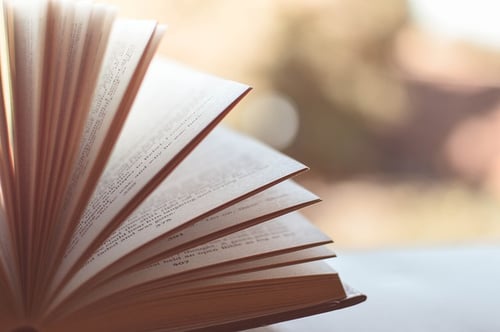
What Are Literary Devices and Wherefore Should You Know Them?
Lean of Literary Devices: 31 Literary Terms You Should Know
Allegory
Alliteration
Allusion
Anachronism
Anaphora
Anthropomorphism
Asyndeton
Colloquialism
Epigraph
Epistrophe
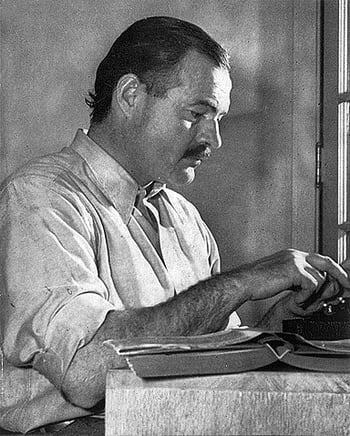 Hemingway, lost all but what quotation to pick out for his epigraph.
Hemingway, lost all but what quotation to pick out for his epigraph. Euphemism
Flashback
Foreshadowing
Hyperbole
Imagery
A host of metal Daffodils;
Beside the Lake, beneath the trees,
Fluttering and dance in the breeze. Irony
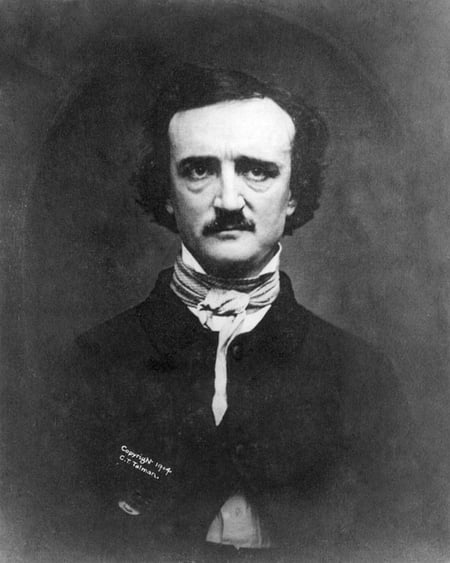 Poe was a fan of satire—and ravens.
Poe was a fan of satire—and ravens. Apposition
Malapropism
Metaphor/Simile
Metonym
Mood
Onomatopoeia
Oxymoron
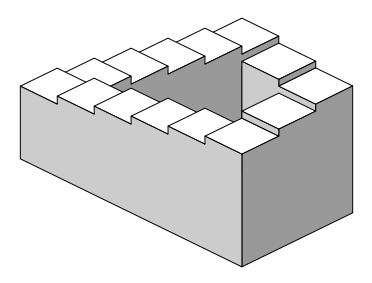 The Penrose stairs = a classic object lesson of a paradox. Are they going up or pull down?!
The Penrose stairs = a classic object lesson of a paradox. Are they going up or pull down?! Paradox
Personification
Repetition
Satire
Soliloquy
Symbolism
Synecdoche
Tone
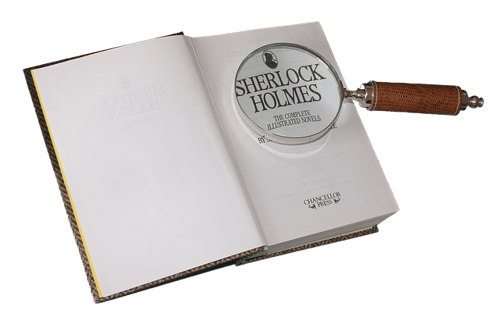 Time to get your own Sherlock Oliver Wendell Holmes!
Time to get your own Sherlock Oliver Wendell Holmes! How to Identify and Analyze Literary Devices: 4 Tips
Lead 1: Read Closely and Carefully
Crown 2: Memorize General Literary Terms
Tip 3: Know the Generator's Intended Audience
Tip 4: Call for Notes and Bookmark Key Passages and Pages
What's Next?



About the Author
Hannah received her MA in Asian nation Studies from the University of Michigan and holds a bachelor's arcdegree from the University of Southern Golden State. From 2013 to 2015, she taught West Germanic language in Japan via the JET Program. She is passionate about didactics, written material, and go.
what literary devices are used in this reading passage
Source: https://blog.prepscholar.com/list-of-literary-devices-techniques
Posting Komentar untuk "what literary devices are used in this reading passage"